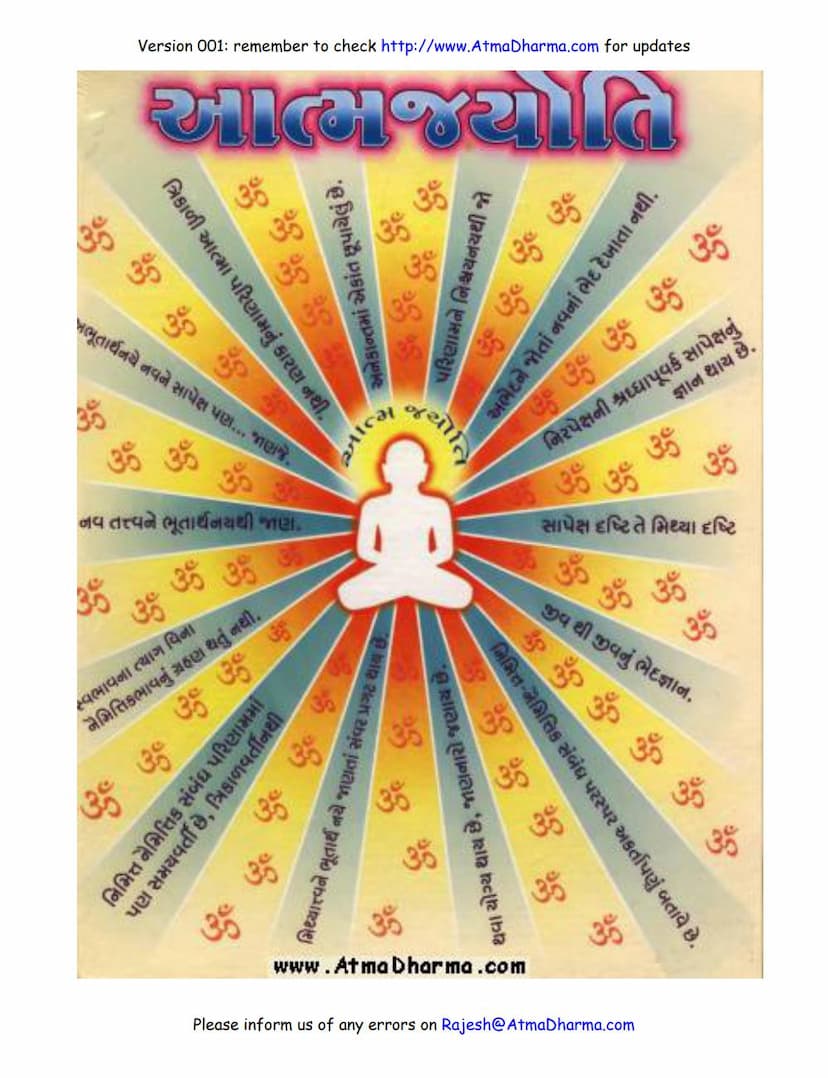Atmajyoti
Added to library: September 1, 2025

Summary
Here's a comprehensive summary of the Jain text "Atmajyoti" based on the provided pages, focusing on its core philosophical teachings:
Book Title: Atmajyoti (The Light of the Soul) Author: Lalchandra Pandit Publisher: Digambar Jain Kundamrut Kahan
Core Theme: Realizing the True Nature of the Soul (Atma)
The "Atmajyoti" text, compiled from the discourses of Pujya Lalchandbhai, delves deeply into the Jain philosophy, particularly emphasizing the realization of the soul's (Atma) true nature, which is pure consciousness, knowledge, and bliss. It aims to guide the reader beyond the conventional understanding of Jain tenets to a direct, experiential realization of the self.
Key Philosophical Concepts and Teachings:
-
The Soul (Atma) as the True Reality: The central message of Atmajyoti is the absolute distinction between the soul (Atma) and its accidental qualities or conditions (Paraya). The soul is described as eternal, unchanging, and the pure knower (Gyata) and seer (Drashta). It is beyond cause and effect, action and inaction, creation and destruction.
-
Critique of Externalism and Ritualism: The text strongly criticizes the reliance on external actions, rituals, or even external knowledge of scriptures without direct inner experience. Practices like devotion to deities, adherence to external vows, or merely knowing the nine tattvas (principles) through scriptures are deemed insufficient for liberation. True liberation comes from the direct, unmediated experience of the soul.
-
Nayas (Viewpoints) and Their Role: The text extensively discusses the concept of Nayas (viewpoints) in Jain philosophy, particularly Nischaya Naya (the ultimate reality viewpoint) and Vyavahar Naya (the conventional or worldly viewpoint).
- Nishchay Naya: This viewpoint is emphasized as the path to liberation. It focuses on the soul's essential nature, its inherent purity, and its freedom from all external conditions and relationships. The soul is seen as self-reliant, self-illuminating, and beyond all dualities.
- Vyavahar Naya: This viewpoint acknowledges the conventional reality of the world, including the nine tattvas, karmic influences, and the causal relationships observed in the empirical world. While Vyavahar Naya describes how things appear to function in the world, it is ultimately considered provisional and not the ultimate truth. The text clarifies that even the nine tattvas, when viewed through the lens of Nishchay Naya, are revealed to be ultimately unreal or illusory in relation to the soul's true nature.
-
The Soul as Unattached and Unaffected: A significant portion of the text focuses on the soul's unattached nature. It clarifies that the soul does not perform actions, nor does it experience the consequences of actions (karma). The soul is merely the witness, the knower. Concepts like "thava yogya thay chhe" (it happens as it is meant to happen) and "jananaro janay chhe" (the knower is known) are used to illustrate the soul's passive, detached nature. The soul is neither the doer nor the experiencer of its own modifications (Parayas) or external phenomena.
-
The Importance of Self-Reliance (Nirapekshata): The text repeatedly stresses the importance of self-reliance (Nirapekshata) in spiritual realization. The soul's true nature is independent and absolute. Relying on external factors, rituals, or even the understanding of conventional truths (Vyavahar Naya) hinders the direct experience of the soul. The path to liberation involves turning inwards and realizing the soul's inherent purity and self-sufficiency.
-
Understanding Cause and Effect: The text clarifies the intricate relationship between causes and effects (Nimitta-Naimittika). While conventional reality describes causal links, the ultimate reality (Nishchay Naya) reveals that the soul, in its essence, is beyond these relationships. The soul is the knower, not the doer or experiencer, of these phenomena. Even karmic processes are viewed as happening due to their own nature and time, with the soul merely witnessing them.
-
The Path to Liberation (Moksha): The ultimate goal is Moksha, which is described as the realization and embodiment of the soul's true, pure, and eternal nature. This is achieved through right faith (Samyak Darshan), right knowledge (Samyak Gyan), and right conduct (Samyak Charitra), which are not external actions but rather the direct experience of the soul's inherent purity and detachment. The key is to shift one's perspective from the external and accidental to the internal and essential.
-
Guidance from Great Souls: The discourses often refer to the teachings of revered Jain Acharyas like Kundakundacharya and Pujya Lalchandbhai himself, emphasizing the importance of following the guidance of true spiritual masters (Gurudev) who have realized the soul.
Structure and Style:
- The text is presented as a collection of discourses (Pravachans) given by Pujya Lalchandbhai.
- Each discourse is numbered and dated, indicating its origin.
- The discourses are rich in philosophical explanations, often using analogies and examples to clarify complex Jain concepts.
- There's a strong emphasis on the practical application of these principles through introspection and self-awareness.
Overall Message:
"Atmajyoti" serves as a profound guide for spiritual seekers aiming for liberation. It systematically dismantles misconceptions about the self and the path to liberation, directing the reader inward to discover the radiant, eternal, and unchanging light of the soul, which is already present within. The emphasis is on direct experience and unwavering faith in the soul's inherent purity, achieved by understanding the correct application of different viewpoints (Nayas) and prioritizing the ultimate reality (Nishchay Naya).